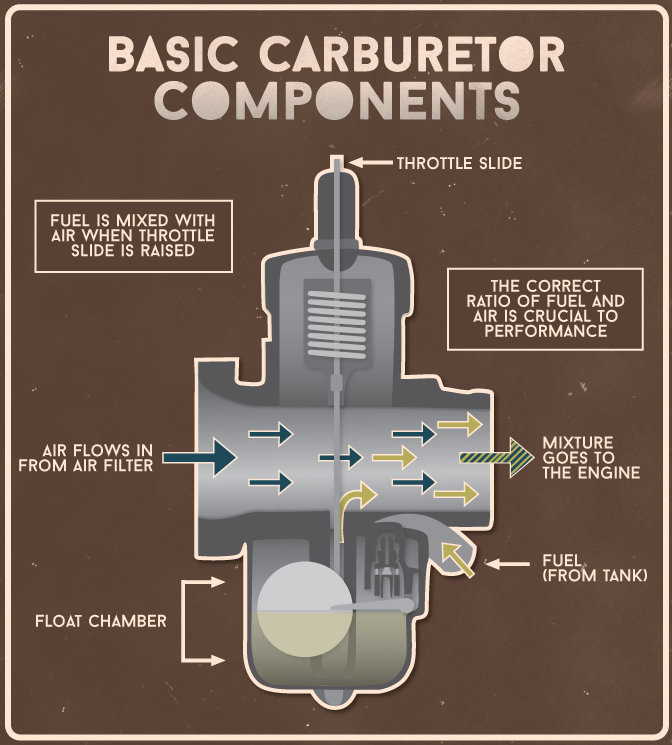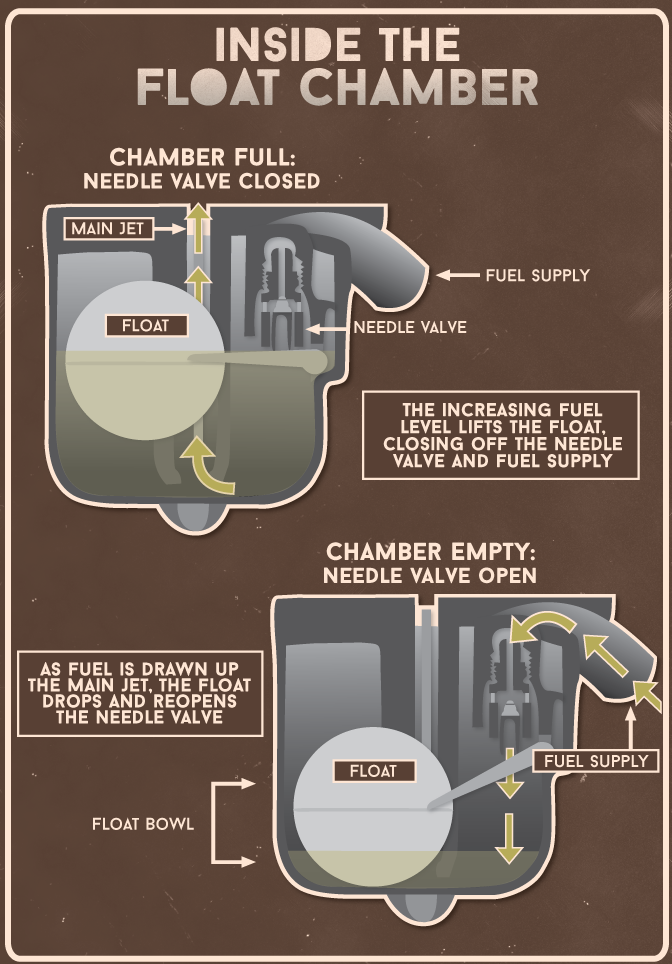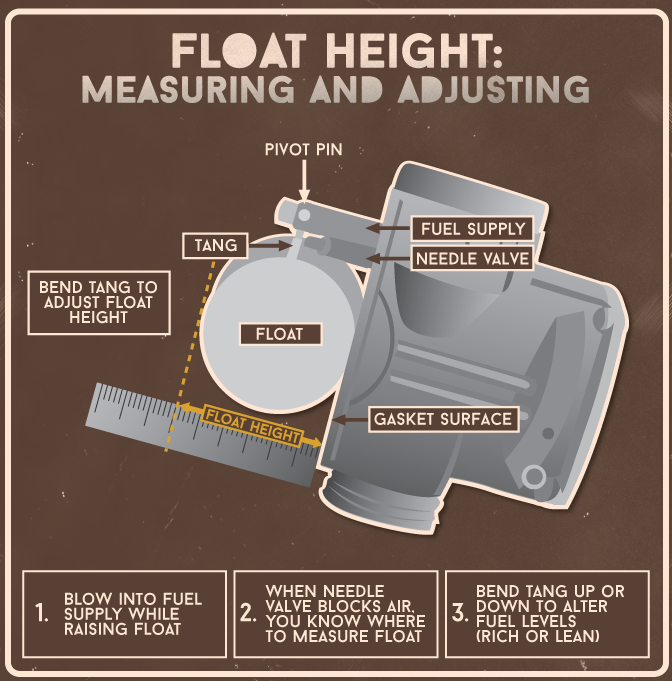Motorcycle Carburetors:
Adjusting the Float Height
The carburetor is probably the most misunderstood mechanical part on a motorcycle and many small engine machines. All engines require a proper mixture of air and fuel for combustion; the strange device known as the carburetor controls the ratio of the fuel/air mixture entering the engine. This sounds simple enough, but there are many carburetor parts that, if not set properly, will at best cause the bike to run badly, or at worst keep it from running at all. The correct ratio of fuel and air is crucial for engine performance.
How It Works
Air enters the carburetor from the air intake, and speeds up drastically, due to the narrowing of the interior walls of the carburetor. This air is blowing perpendicular to the throttle slide – a valve controlled from the throttle cable. When the throttle is opened, the cable raises the throttle slide located inside the carburetor’s main body. As the slide rises, the fast moving air pulls the fuel up the main jet from the float chamber. This works automatically because the fuel wants to travel from an area of high pressure (the float chamber) to an area of low pressure (the carburetor main body).

The fuel mixes with air and heads into the engine. The amount of fuel that flows is dependent on the position and size of the needle valve (explained below), the size of the main jet, and the height level of the fuel in the float chamber. The fuel height in the float chamber is controlled by the floats. Adjusting these floats is explained below.
Inside the Float Chamber
Looking more specifically at the float chamber, you will find the float. This simple device controls the amount of fuel that enters the float chamber, restricting or cutting off the supply by its settings.
Float Chamber Components:
Needle valve assembly
Floats
Float pivot rod
Chamber and gasket
Drain plug
The float chamber is a reservoir for fuel, and contains all of the working components of the float. Most float chambers are fixed to the base of the carburetor, but some early machines used a remote system where the chamber was located some distance away from the main carburetor body. Most float chambers have a drain fitted for maintenance and, in some cases, to measure the actual fuel height.
The Float and Needle
The floats in a carburetor are typically made from either brass or plastic. The float chamber actually works similarly to a toilet tank. The floats essentially “float” on the fuel in the float chamber. The floats pivot on a rod and, via the tang, open or close the needle valve, causing fuel to enter or not enter the chamber. When fuel is drawn up the main jet, the fuel level in the chamber drops, thus the float also drops. This opens the needle valve allowing more fuel to enter the chamber. When the float again rises with the fuel level, the needle valve will close off the fuel supply.
Needle Valve
With a spring-loaded clip at one end and a tapered rubber tip at the other, the needle valve works in unison with the float. The needle valve also works with the seat assembly, which is simply a screw-in brass bolt – drilled to take the shape of the rubber tipped needle. The seat assembly is the end of the fuel line, where fuel is waiting to enter the chamber. When the chamber is full, the rubber-tipped needle is pressed into the seat, preventing fuel from overflowing the chamber.
Note: Different sized needles and seat assemblies are available for specialty requirements like racing and altitude corrections – the fuel requirement is lower at higher altitudes due to a lower atmospheric pressure.

Setting the Float Height
You want to set the float height so the bike runs on the exact amount of fuel it needs – no more, no less. To set the float height, it is first necessary to determine the current settings. This can be done in two ways: by using an external measuring pipe, or by measuring the physical height of the float above the gasket face.
External Measuring Pipe Method
This method of determining the actual fuel level (against the float height level) uses an adapter that fits into the drain hole of the float chamber. A clear fuel line with graduations is fitted to the adapter. Once the fuel is turned on, fuel flows up the pipe until the needle valve assembly closes the supply; the fuel height in the tube corresponds to the fuel height inside the float chamber.
Note: Some carburetors have a drilled protrusion on the base of the float chamber to which the clear fuel pipe can be attached for fuel height measurements.
Physical Height Measurement Method
When using this method to check float height, first remove the float chamber bowl from the main carburetor body. With the chamber removed, tip the carb onto its side, in the same position it takes while fitted to the bike. Now blow into the fuel supply pipe, while simultaneously lifting the floats slowly until the air flow stops. This is the measuring point for the specified float height.
The distance to measure is available from the manufacturer and can also be found in all good shop manuals (double-check any distances quoted in forums on the internet). The distance is typically measured from the float chamber face – or gasket surface – to the highest point of the floats. If the floats are not at the right height, the tang on the floats should be bent toward the needle valve for less fuel to be allowed in (the bike runs leaner) or, conversely, away from the valve to increase the fuel level (bike runs richer).

Symptoms of Incorrect Float Heights
In an extreme case, if the floats are set too high, fuel will overflow via drillings inside the carb body. In addition, fuel may flow into the engine unrestricted, which, if the engine is not running, can cause hydraulic lock – that is, as the piston rises on the compression stroke it cannot compress the fuel.
If fuel is leaking from the carb, it can potentially cause a serious problem – fire. If the fuel height is too high but the bike is running, the engine will have a tendency to display a rich running condition, which will make the throttle response slow and the engine note muffled. This condition is generally accompanied by a strong smell of unburnt fuel from the muffler. If the fuel height is too low, the engine will display a lean running condition, where the engine typically hesitates before accelerating or surges as the throttle is opened. The bike may also misfire when the throttle is closed.
Embed the article on your site

